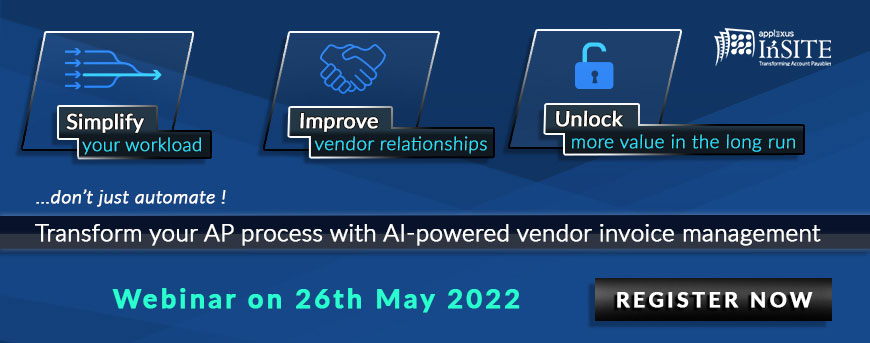10 cost-saving measures to improve ROI for invoice processing?
05 May 2022


Sumitro Giri
Associate Director- AI/MLSumitro Giri is the Manager – Marketing & Product Management at Applexus, with expertise in B2B operations, supply chain, and marketing. He has over four years...
Businesses want to leverage the highest financial benefits from their investments. Ideally, every dollar invested in labor, technology, machinery, or other classes must produce significant returns. Companies always consider the Return on Investment (ROI) on every expense.
ROI is a popular metric used by businesses to gauge the value of their financial investment in managing their Accounts Payable processes. If they don’t see any foreseeable returns, then the likelihood of investing there comes down.
Businesses first establish what they hope to achieve, overall returns, how much they can save, and how much of it is coming their way. If they don’t seem confident in attaining their objectives within the preset budget, then they’ll likely not commit any money on that end. Let’s see what ROI a business can get from its Accounts Payable (AP) team.
Why does Return on Investment matter in Accounts Payable?
AP is a vital cog in your business, and to justify any investment in AP, companies wish to know the actual profitability of that investment. Despite the high initial investment or running costs, the averseness to invest will come down considerably if the returns look bright. The appeal lies in getting a high ROI percentage.
The average cost of a paper invoice can range anywhere between $12 to $30. However, fully-automated invoices cost just $3.50 per invoice - Sterling
Accounts Payable is a cost center. It can be a tedious and error-ridden process if done manually, resulting in irregularities that have a profound impact on your cash flow. Thus, businesses look to invest in a solution that can optimize the processes and do so while offering the best returns and maximum savings. The AP department mainly drains its cash through:

Since Accounts Payable is such a pivotal part of your company's finances, reducing the above costs associated with your invoice processing can reduce the business expenses significantly, improving the bottom line, improving cash flow, and your year-end cash in hand and total capital. Offline and manual or even semi-automatic AP processes are not the best ways to generate high ROI.
To calculate the true benefit of a transformation, organizations must translate the returns into quantitative and qualitative terms. For calculating ROI for Accounts Payable transformation projects, we will explore the quantitative benefits in this blog.

A positive ROI can be a great sign, but you may also need to factor in the risk tolerance and the time required to generate the return. The ROI metric will reveal how well new solutions and digital initiatives will fare in the long run.
Increase ROI through Accounts Payable Management Approach
The Accounts Payable process is dominated by manual functions, such as keying/entering invoices, tracking past invoices, routing invoices, tracking payment dates, and so on. AP process involves an ecosystem of multiple functions such as Procurement, Finance, Logistics, and Supplier Management. Managing this ecosystem demands a solution that addresses the invoice management and management aspects of the process.
Automating the manual processes with a management approach is known to work wonders for many AP teams right away. Removing manual processes cuts the time, effort, and labor costs in many administrative sections of your backend operations. Plus, collaboration, communication, and a user-friendly interface to help the AP team manage their day-to-day activities results in a greater return on human capital and improves the overall experience of the AP team as well as other functions involved in processing an invoice.
76% of businesses say that 'smarter' systems that drive more efficiencies are critical to AP's success - The State of ePayables
A well-oiled invoice processing mechanism, with an invoice management and management approach, provides the easiest and quickest ROI.

Increase ROI through Reduction in COGS in the Invoice Processing Cycle
The Cost of Goods Sold (COGS) is often dependent on the amount you spent to procure the raw materials for the goods you end up manufacturing, besides other factors. In many instances, the inability to procure these raw materials cheaper results in your COGS escalating every quarter. Besides, negotiating for better discounts, you’ll also need to lower the costs on your end and manage the variables you can control. Believe it or not, some of these variables rest with the AP team.
This is usually capturing the early payment discounts and avoiding late payment penalties, which can really reduce these expenses that exasperate your COGS and therefore burn a bigger hole in your working capital. Moreover, duplicate, and fraudulent invoices also increase the ultimate landing cost of the goods.
To improve your finances and increase the money in your coffers, the Accounts Payable (AP) team needs close collaboration with the procurement team to optimize spending. These internal AP practices can sometimes give better returns in the long run.
Increase ROI through improved productivity in the Invoice Processing Cycle
The time lost in manually storing and sifting through invoices, data entry, validation, and other laborious tasks will make your Accounts Payable (AP) less efficient. Time wasted in calibrating and correcting errors in invoices will also affect your closure rates on invoices. What you need is an intelligent and transparent system that manages your AP end-to-end.
As your AP clerks are far more occupied in time-consuming activities, they often miss out on due dates and sometimes even misplace and lose invoices. The lack of tracking, activity log, and other flaws in a manual ecosystem leads to penalties and increases your expenses unnecessarily.
A lot of AP activities require just more than automation. It needs a single platform to process, track and collaborate with other functions across the eco-system. An automation solution without a process improvement approach may result in a sub-optimized process.
Increase ROI by effectively managing Compliance Risks in Invoice Processing
Businesses can even manage their compliance better and avoid any risks associated with fraudulent invoices. The product's AI helps identify any unusual behavior, such as a fraudulent or duplicate document. The AI can even flag deceitful transactions and notify the concerned decision-makers.
Every personnel on either side will have complete visibility of every activity or change that has ever taken place on any document. A log creates a summary of the tweaks from the AP clerk and someone on the supplier side. Accountability will never become an issue since changes fully view everyone.
Processing of AP invoices without tracking, activity logs, and validation mechanism often lead to various compliance and security risks. Integrating invoice management into these processes will reduce the number of AP clerks who access the document.
Maintaining a simple and user-friendly tracking mechanism with a retrieval process in place also reduces a lot of time in auditing.
Value Map – Our approach to ascertain true Monetary value in Accounts Payable Transformation Projects

A value-oriented framework validates the plethora of benefits in store for your AP team via invoice management powered by intelligent automation. Almost every function of your AP team will receive a boost by incorporating a digital solution. A digital alternative to your legacy processes will remove manual data entry, improve efficiency, increase productivity, reduce errors, and reduce the time to process each invoice.
Furthermore, all the above benefits will translate into monetary savings for the company. Better invoice management in AP will reduce paper costs, remove erroneous payments through duplicate and fraudulent invoices, reduce the wages per AP head, reduce communication costs, and help you avoid non-compliance and late fee charges.
Top 10 areas where your AP team can maximize savings?
Businesses can achieve the best returns from better invoice management. Savings per invoice, which might seem minuscule, adds up and pays rich dividends at the end of the financial year. And as the saying goes, “every little count,” so why give up these benefits. Here are some top returns to bank on:
Capture early Payment Vendor Discounts – Suppliers want to be paid early and in turn, they offer the best discounts for payments done before due dates. The AP team can easily capture these early payment discounts to save more money and boost their cash flow.
Typical early-pay discounts are 2% of PO spend - IOFM
Avoid Late Payment Penalties - No more delays - avoid late payments and all the fines and penalties arising due to it. Most businesses end up increasing their expenses as a result of a missed deadline. In a human-driven ecosystem with multiple suppliers, it’s quite common to see yourself getting overwhelmed with numerous payment dates.
Goldman Sachs estimates assume 5% of all invoices are 30 days past due - GS Publishing
- Save on paperwork costs - In the past, invoice processing meant dealing with paper invoices. An automated invoice processing solution enables you to receive electronic invoices efficiently and quickly from suppliers. Save on invoice processing costs by not printing and faxing every document that comes your way.
Workforce Costs - Reduce staff and spend way less on AP team members in a year. Manual data entry processes require more labor, which then means reserving a good amount of your revenue share for paying these resources. But invoice management handles most of the tedious tasks to help you downsize or rely on fewer workers to manage the whole invoice processing cycle. The number of resources required to handle invoices decreases significantly.
AP invoice management can drive 70-80% time savings for AP staff - GS Publishing
- Avoid overspending - No lost invoices will ever result in your business paying more money to the supplier than was finalized. Lost invoice results in late payments, seeing as manually processing too many invoices ends up becoming a burden on the AP team who find it hard to keep track of everything and in the process lose a few invoices.
- Save yourself from fraudulent invoices - A fraudster sends an invoice to the AP team, as one of the company’s existing suppliers or pretends to be a new supplier. The invoice includes the fraudster’s bank account details. You end up paying and lose a ton of money in the process.
- Avoid underpaying your suppliers - No more underpayments as a result of human error and that saves you from fines as well. Someone in the AP team misreads the invoice and that results in a lower payment, which causes delays and leads to fines. An invoice processing invoice management solution will clear these gaps and ensure more accuracy.
More Self-service means less reliance on the AP team – Suppliers can easily access the collaboration portal to view and download documents, plus know the status of invoices to confirm payments. This relieves your Accounts Payable team from routine supplier inquiries, and they can focus more on revenue-generating activities or the front-end customer experience.
According to a survey by Hyland Software, AP employees spend an average of 7% of their time collecting data (e.g., purchase orders and invoices) - GS Publishing
Avoid duplicate Payments - The high-end OCR tech, combined with the in-built AI, detects duplicate invoices which help to avoid repayments, thereby bringing down expenses. Very often, the AP team ends up paying on the same invoice twice which only widens the cash crunch on the business.
19% of organizations surveyed reported a duplicate payment rate of between 0.1% and 0.5% - IOMA
- Better relationship, maximizes returns - Expedite responses and streamlined invoice processing improves supplier relationships, possibly resulting in better purchase rates. Businesses, after consistently depositing payments on time can even negotiate for better early payment discounts in the future.
Conclusion – Improve cash flow for Accounts Payable
The Accounts Payable team in your business needs to do more with less. Managing the whole invoice cycle, and keeping up with the suppliers and procurement team while ensuring compliance – needs more than automation. A process management solution can add value, save money, and improve cash flow. A solution that intelligently combines Invoice management, Analytics, and AI-driven automation to ease the backend processes and yield monetary returns. These returns are the true measure of every dime invested in a digital solution.
Join us on 26th May, 10 AM CST for an insightful session on a value-driven approach to transforming your accounts payable process.













